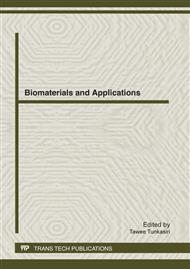p.461
p.465
p.469
p.473
p.477
p.481
p.485
p.489
p.493
Customized Three Dimensional Printed Porous Polyethylene for Calvarial Reconstruction
Abstract:
Porous polyethylene has been widely used for cranio-maxillofacial procedures due to its highly stable, flexible and has been shown to exhibit rapid soft-tissue and bone ingrowth. Generally, it is available as standard shape which needs to be intra-operatively contoured and manually adapted to fit the defect of each patient. In this study, a technique of producing customized porous polyethylene implant for calvarial defect reconstruction was reported. The technique began with acquiring patients data by computed tomography and was three dimensionally reconstructed using a medical imaging software. The shape of implant was then digitally designed to fit the defect based on the patients anatomy and transferred to three dimensional printing machine to fabricate the implant using proprietary polyethylene formulation as raw material. This technique can be used to cover any cranial defect size, offering similar or even better cosmetic results to standard alloplast cranioplasty while decreasing operation time. This customized porous implant can permit ingrowth of tissue to increase interface stability, implant strength and decrease the risk of infection similarly to commercial product.
Info:
Periodical:
Pages:
477-480
Citation:
Online since:
April 2012
Keywords:
Price:
Сopyright:
© 2012 Trans Tech Publications Ltd. All Rights Reserved
Share:
Citation:


